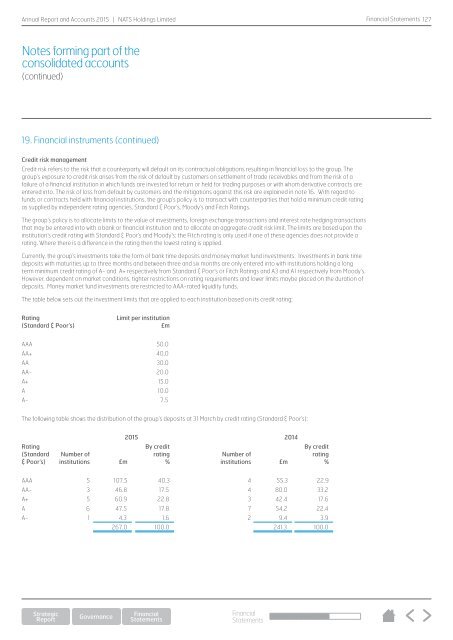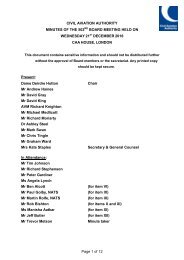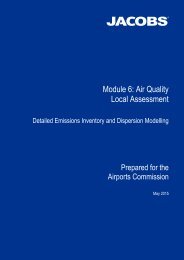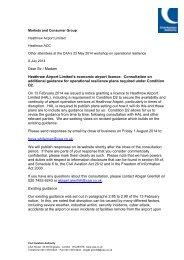NATS-Annual-Report-2015
NATS-Annual-Report-2015
NATS-Annual-Report-2015
Create successful ePaper yourself
Turn your PDF publications into a flip-book with our unique Google optimized e-Paper software.
<strong>Annual</strong> <strong>Report</strong> and Accounts <strong>2015</strong> | <strong>NATS</strong> Holdings Limited<br />
Financial Statements 127<br />
Notes forming part of the<br />
consolidated accounts<br />
(continued)<br />
19. Financial instruments (continued)<br />
Credit risk management<br />
Credit risk refers to the risk that a counterparty will default on its contractual obligations resulting in financial loss to the group. The<br />
group’s exposure to credit risk arises from the risk of default by customers on settlement of trade receivables and from the risk of a<br />
failure of a financial institution in which funds are invested for return or held for trading purposes or with whom derivative contracts are<br />
entered into. The risk of loss from default by customers and the mitigations against this risk are explained in note 16. With regard to<br />
funds or contracts held with financial institutions, the group’s policy is to transact with counterparties that hold a minimum credit rating<br />
as supplied by independent rating agencies, Standard & Poor’s, Moody’s and Fitch Ratings.<br />
The group’s policy is to allocate limits to the value of investments, foreign exchange transactions and interest rate hedging transactions<br />
that may be entered into with a bank or financial institution and to allocate an aggregate credit risk limit. The limits are based upon the<br />
institution’s credit rating with Standard & Poor’s and Moody’s; the Fitch rating is only used if one of these agencies does not provide a<br />
rating. Where there is a difference in the rating then the lowest rating is applied.<br />
Currently, the group’s investments take the form of bank time deposits and money market fund investments. Investments in bank time<br />
deposits with maturities up to three months and between three and six months are only entered into with institutions holding a long<br />
term minimum credit rating of A- and A+ respectively from Standard & Poor’s or Fitch Ratings and A3 and A1 respectively from Moody’s.<br />
However, dependent on market conditions, tighter restrictions on rating requirements and lower limits maybe placed on the duration of<br />
deposits. Money market fund investments are restricted to AAA-rated liquidity funds.<br />
The table below sets out the investment limits that are applied to each institution based on its credit rating:<br />
Rating<br />
(Standard & Poor’s)<br />
Limit per institution<br />
£m<br />
AAA 50.0<br />
AA+ 40.0<br />
AA 30.0<br />
AA- 20.0<br />
A+ 15.0<br />
A 10.0<br />
A- 7.5<br />
The following table shows the distribution of the group’s deposits at 31 March by credit rating (Standard & Poor’s):<br />
Rating<br />
(Standard<br />
& Poor’s)<br />
Number of<br />
institutions £m<br />
<strong>2015</strong> 2014<br />
By credit<br />
rating<br />
%<br />
Number of<br />
institutions £m<br />
By credit<br />
rating<br />
%<br />
AAA 5 107.5 40.3 4 55.3 22.9<br />
AA- 3 46.8 17.5 4 80.0 33.2<br />
A+ 5 60.9 22.8 3 42.4 17.6<br />
A 6 47.5 17.8 7 54.2 22.4<br />
A- 1 4.3 1.6 2 9.4 3.9<br />
267.0 100.0 241.3 100.0<br />
Financial<br />
Statements






